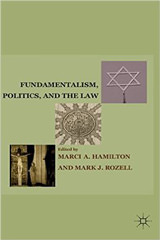Next week, the Supreme Court will hear argument in the case of Holt v. Hobbs, in which a Muslim inmate in an Arkansas prison is arguing for the right under the Religious Land Use and Institutionalized Persons Act (RLUIPA) to have a beard in violation of the prison’s rules. RLUIPA is the federal law that imposes on local and state governments the same standard as that imposed by the Religious Freedom Restoration Act (RFRA) federal law, and which was at issue in Burwell v. Hobby Lobby. To wit, a prison may not substantially burden an inmate’s free exercise of religion unless serving a compelling interest in the least restrictive means. The standard is one that was never applied to prisons before RFRA and RLUIPA appeared on the horizon in 1993 and 2000 respectively.
Currently, the Arkansas prison officials in this case permit ¼-inch beards for medical reasons (which likely means they must also for religious reasons under the First Amendment), but they have objected to Holt’s demands for a longer beard. The advocates for extreme religious liberty have heaped condescension on the prison authorities for their concerns. It’s just a ¼ inch, right?
But what is really at stake is how deeply involved federal courts will become in the micromanagement of state prisons and the nationalization of religious accommodation across all local, state, and federal prison systems. Not to mention how prisons are supposed to handle their most violent inmates with the federal courts looking over their shoulders.
The Prison Policy and the Jihadist Inmate
This prison policy, which is common among state prisons, was implemented for “health and hygiene”; to maintain a “standard appearance throughout . . . incarceration”; to “minimize opportunities for disguise”; and to “minimize opportunities for transport of contraband and weapons.” These are interests few could denigrate, unless they do not know how prisons operate or what prisoners are like.
The inmate in this case is a jihadist, who was indicted for threatening the lives of the daughters of Pres. George W. Bush, and was in prison for breaking into his ex-girlfriend’s home, slitting her throat, and stabbing her in the chest. While in prison, he was caught holding a knife to an inmate’s throat. In other words, he was violent inside and outside prison.
Eighteen states submitted the sole amicus brief in support of the prison, but in my view it is the brief the Justices and their clerks need to read the most closely. The federal courts are inclined to set a single standard across the country, but the states have warned the Court that when it comes to the fifty state and hundreds of municipal prisons, and the different demographics of the prison population across the country, one size does not fit all:
“Prison life is not civilian life, and federal judges are not equipped to weigh the unique security concerns and resource constraints faced by prison administrators. Staffing and funding levels vary, as do the physical layouts and disciplinary problems of each prison. Prison administrators are in the best position to craft the restrictions necessary to maintain health and safety in the unique context of each prison’s environment.”
The Supreme Court Precedent That Matters the Most
The legal debate revolves around dictum in the Court’s unanimous decision, Cutter v. Wilkinson, where the Court upheld RLUIPA’s prison provisions against a facial Establishment Clause attack. The unanimous opinion, written by Justice Ruth Bader Ginsburg, was leavened with prescriptions to the federal courts to defer to prison administrators’ judgments on prison security. The Court relied upon the legislative history of RLUIPA: “Lawmakers anticipated . . . that courts entertaining complaints under §3 would accord ‘due deference to the experience and expertise of prison and jail administrators.’” Later on, the decision noted that members of Congress “anticipated that courts would apply the Act’s standard with ‘due deference to the experience and expertise of prison and jail administrators in establishing necessary regulations and procedures to maintain good order, security and discipline, consistent with consideration of costs and limited resources.’”
The Respondent prison embraces the dictum of Cutter, asking the Court to give due deference to the views of prison administrators on security, which decisions are made on a system-by-system basis in light of the inmate needs and demands in that system. The states’ amicus brief further argues, “It is the considered opinion of the amici States that Cutter’s deferential test appropriately balances the religious liberty of inmates with the unique institutional concerns of prison life. The Court should continue to ascribe ‘due deference to the experience and expertise of prison and jail administrators.’” It only makes sense that beard length matters, because uniformity of appearance is necessary for guards to be able to identify the troublemakers from the rest. Moreover, it is a commonplace that inmates hide contraband wherever they can and prison systems struggled with the cost of having to visually check beards that are longer. They also rightly complain that federal courts should not be in the business of undermining prison security unless there is some massive statistical survey or study for each particular practice.
Holt, the Petitioner, insists that RLUIPA must be read solely according to its expansive terms, particularly in light of the Supreme Court’s reading of RFRA’s terms in Hobby Lobby, and Cutter means little for this case. That means the prison must prove with specificity and preferably with studies and statistics that its beard-length policy is the least restrictive means for this inmate. It is not enough for prison administrators from Arkansas and 18 other states to aver that this is a needed security measure. The Petitioner also argues that if other prison systems would permit him to have his half-inch beard, then this one must, too: “At least 43 states and prison systems, several large municipal systems, and national accreditation standards would allow Petitioner’s beard.”
For the Petitioner, the cost of inmate-by-inmate beard inspections is a joke, and the overall cost of litigating RLUIPA claims inmate-by-inmate across all prison systems in the United States poses no concern at all. On the Petitioner’s view of the universe (and that of the many religious groups that filed amicus briefs in this case), the right to extreme religious liberty should come at any cost to the government (aka the taxpayers) and the federal courts properly oversee every particularized claim for religious accommodation in the United States, with a growing list of mandated accommodations across all prisons, regardless of the prison’s inmate population, budget, or religious makeup.
If Cutter cabined RLUIPA, as its dictum seems to indicate, and as Justice Ginsburg reiterated in her dissent to Hobby Lobby, the state should win this case, and the federal courts will not be in the business of micromanaging every accommodation in every prison. If the inmate wins this one, RLUIPA will reveal itself as the intense invasion of federalism it is, and the federal courts will need to adjust their dockets to free up time and resources to serve as super prison boards. Since Congress imposed RLUIPA on the prisons and the federal courts, it is only fair for it to appropriate more funding for the federal judiciary so as to accommodate all of the likely future demands for RLUIPA-engineered accommodations prisoner by prisoner.










I don’t think a short beard — though can respect concerns for prison security (could they find a less pleasant plaintiff? thousands of Muslims are in prison for a range of crimes, many of whom could have made this claim … but then since the article briefly notes many prison systems would allow the beard, I can see why so few claims might arise) — is an “extreme” religious liberty claim.
Justice Alito as a lower court judge outside the prison context upheld such a claim (beard allowed for health reasons) but prisons have traditionally led to less rights. But, religious rights still are upheld in various ways. It is likely popular ones will honored more by choice and unintentionally out of familiarity. The case is a bit harder than this article says but it’s p.o.v. is a good one to include in the conversation.
Most respectfully, your position is not entirely supported by the empirical evidence. The Federal
Prison system (BOP) has no such restrictions on facial hair and that
system does cut across the “fifty states…and the different
demographics across the 50 states.” Not to mention that the BOP houses what are arguably the most dangerous inmates in America. Also, your parenthetical statement
that under the first amendment the AK prison system must also offer the
1/4 inch accommodation for religious reasons once it’s offered for
medical reasons, while legally sound, is incorrect as to real world application in this instance. In fact, no such 1/4 inch accommodation is
presently made for religious practices in AK prisons despite the medical accommodation. I will agree, however, that feel-good laws such as RFRA have unintended negative consequences and generally serve to crack the wall separating church and state. And that is never a good thing.